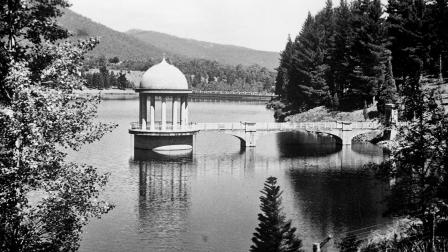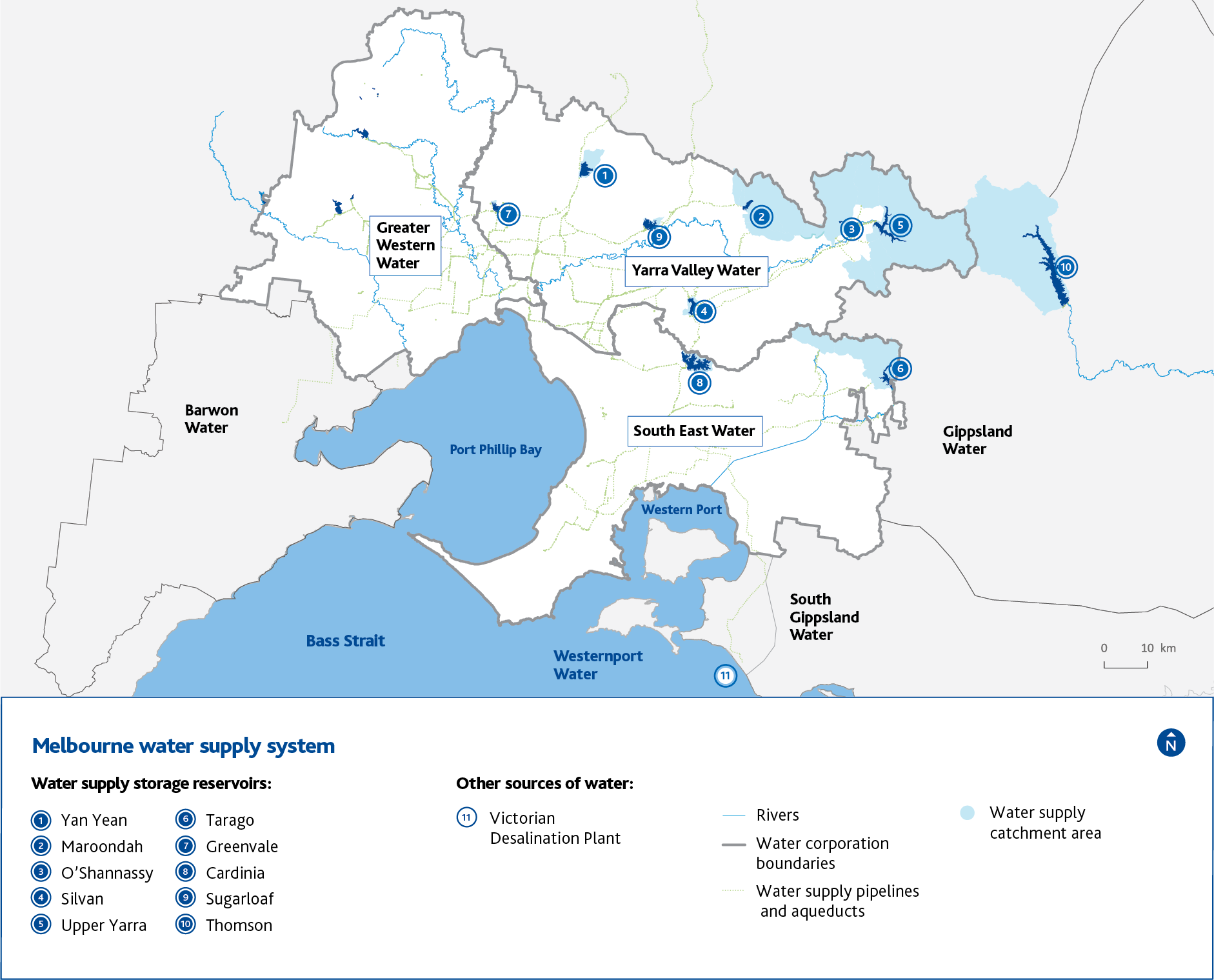Get to know Melbourne’s 10 major reservoirs, which store water collected from the catchments and supplied by the Victorian Desalination Plant (when in operation).
A reservoir is a large natural or artificial water storage, often formed by building a dam across a river. Together, our 10 major reservoirs can store up to 1,812 billion litres of water, and vary in size from the smaller O’Shannassy (3 billion litres) to the massive Thomson (1,068 billion litres).
We also manage 38 smaller service reservoirs dotted around Melbourne, which store water for 1-2 days so there’s always some available to meet demand.
How full are our reservoirs?
For daily data on the current state of our storages – individually and overall – check out our water storage levels web app.
Reservoir types
Our major reservoirs fall into two categories: on-stream and off-stream.
On-stream reservoirs
On-stream reservoirs are filled by rivers or rainfall that runs off the nearby forested water catchments.
| Reservoir | Water source | Supplies |
Capacity (GL) |
|---|---|---|---|
| Thomson | Thomson State Forest and a small part of Baw Baw National Park | Upper Yarra Reservoir | 1,068 |
| Upper Yarra | Yarra Ranges National Park, Thomson Reservoir | Silvan Reservoir | 200 |
| Tarago | Bunyip State Forest | Melbourne’s southeast | 37 |
| Yan Yean | Toorourrong catchment, Silvan Reservoir, Winneke treatment plant | Melbourne’s north | 30 |
| Maroondah | Watts River catchment and Graceburn Creek | Sugarloaf Reservoir | 22 |
| O’Shannassy | O’Shannassy River and Smith Creek | Silvan Reservoir | 3 |
Note: GL = gigalitres (billion litres)
Off-stream reservoirs
Off-stream reservoirs receive water from on-stream reservoirs or other sources, like the North-South Pipeline and Victorian Desalination Plant.
| Reservoir | Water source | Supplies | Capacity (GL) |
|---|---|---|---|
| Cardinia | Silvan Reservoir, Victorian Desalination Plant | Melbourne’s southeast, Silvan Reservoir | 287 |
| Sugarloaf | Maroondah Reservoir, North-South Pipeline | Melbourne’s north, east and centre | 96 |
| Silvan | Upper Yarra, O’Shannassy and Thomson reservoirs | Most of Melbourne | 40 |
| Greenvale | Silvan Reservoir | Melbourne’s northwest and west | 27 |
Note: GL = gigalitres (billion litres)
Protecting reservoirs and water quality
Safeguarding our water supply catchments is one of Melbourne Water’s most important responsibilities, and is essential to providing safe, affordable and reliable drinking water supplies.
Catchment areas and reservoirs which do not allow public access are fenced off and have clear signage that must be obeyed.
Managing our storages
Some of our reservoirs are connected to each other, so we can move water between them when we need to, so water supply across Melbourne is more reliable. We can increase supply to areas when demand is high, or when water supply is interrupted due to repairs or maintenance.
We can transfer water from Thomson to Upper Yarra, Upper Yarra to Silvan, O’Shannassy to Silvan, Maroondah to Sugarloaf, Silvan to Greenvale and Cardinia and Cardinia to Silvan. Tarago Reservoir is not connected to another reservoir. Water is treated at the Tarago Treatment Plant and supplied to the Peninsula. Water from the Desalination Plant enters our supply system at Cardinia Reservoir, where it mixes with water from our catchments, supplied from Silvan Reservoir.
This requires us to navigate a dynamic situation: meeting demand for water in different areas, which can change hourly, while dealing with yearly and seasonal variations in availability – from long, dry periods to wetter years. In practice, this could mean moving water out of a reservoir so it can fill up during heavy rain, or keeping its water levels low while its dam is being maintained.
We know drought can creep up on us quickly, so it’s important we keep our water storages topped up. That’s why desalinated water is critical role to securing our water supply: building a buffer in our storages each year, which can take the pressure off during drier periods and droughts.
You may also like...
Our water supply system
Melbourne has some of the highest-quality drinking water in the world. Learn how it makes its long journey to your tap.

Calculating water storage data
Learn how we calculate water storage levels and why we display data in a particular way.
Hydropower
Our hydroelectric power stations harness a natural, sustainable and reliable source of energy to generate renewable electricity – and reduce our carbon footprint. Learn how it works and the benefits to Melbourne.
Maroondah water supply system
Explore 360-degree views of the heritage-listed Maroondah system, which has supplied water to Melbourne since 1891.

